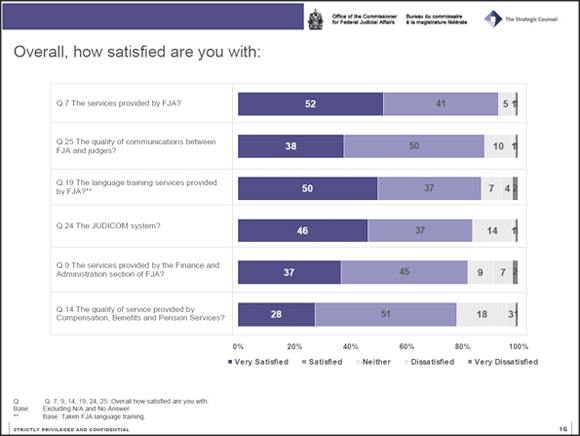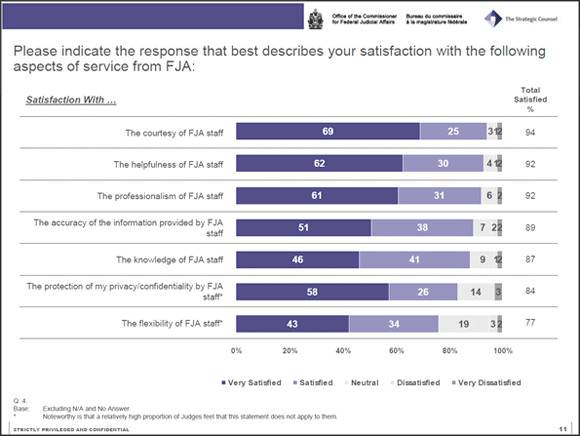2008 Client Satisfaction Survey Executive Summary
Prepared for:
Office of the Commissioner for Federal Judicial Affairs Canada
Prepared by:
The Strategic Counsel
The Strategic Counsel is pleased to present the highlights from a recent client satisfaction survey undertaken on behalf of the Office of the Commissioner for Federal Judicial Affairs (FJA). In the fall of 2008, FJA undertook to formally obtain feedback from its clients, federally appointed judges, regarding their overall satisfaction with the service provided by the organization as well as across specific service areas. The results represent baseline measures of satisfaction which can be tracked at regular intervals and identify some possible areas for improvement.
Research Objectives and Approach
The survey is one of several tools FJA uses to actively listen to its clients and monitor the judicial environment and permits FJA to better understand its clients' administrative needs, identifying if, and where, judges perceive service gaps exist. Conduct of a survey also assists the FJA in planning and delivering service improvements to its clients as mandated by the Treasury Board Secretariat's Management Accountability Framework (MAF).
The questionnaire that was sent to judges was based on the Common Measurement Tool (CMT), a standardized client satisfaction measurement tool developed specifically for public sector organizations, to permit evaluation of results against normative data. Some modifications were made to the CMT to reflect the particular requirements of FJA and the array of services offered.
All judges received preliminary communications about the survey, and were given the option of completing the survey either online (via an email-based web link) or on paper. A total of 1060 invitations were sent during the week of October 27th, 2008. The online survey was activated on October 29th and was active for a period of four weeks following this date. Any mail responses received prior to December 10th, 2008 were also included in the final count of completed surveys.
A total of 609 completed surveys were received prior to the deadline for completion, yielding an overall response rate of 57%. This is a reasonable and expected response rate for such surveys given the time pressures, schedules and availability of the client population to complete such a survey. At an organization-wide level, the results are accurate within +/- 2.6 percentage points, 19 times out of 20.
Please note that the questions included on the survey provided an option for respondents to answer “don't know,” “not applicable” or simply to decline to respond (e.g. DK/NA/Ref). Where respondents were asked to rate their levels of agreement/disagreement or satisfaction/dissatisfaction, for purposes of reporting, these results have been re-calculated to exclude those who responded in this manner. This is common practice when reporting on such measures in client satisfaction surveys, as it is effectively the general tendency among those who had an opinion that offers the best overall picture of levels of satisfaction and the gap between stated importance and performance, as reflected by satisfaction, on a particular dimension of service. However, the tables that follow in this Executive Summary and the more detailed PowerPoint deck do indicate where responses in the DK/NA/Ref category were 14 per cent or higher as this finding in itself is of interest, possibly suggesting an issue or challenge regarding awareness or use of a service, for example. All other tables remain unchanged and include those responding “don't know,” “not applicable” or no response.
Key Findings
Judges report being highly satisfied with the FJA and all of its key functions or service areas.
Overall, the results are positive and indicate high levels of satisfaction in many areas. Nine out of ten judges (93%) reported being satisfied with the services provided by FJA. A similar number (88%) rated FJA as doing a “good” or “excellent” job in fulfilling its mission to support and promote judicial independence by providing services to the Canadian judiciary.
Satisfaction scores were also consistently high across specific service areas, including language training services (87%), finance and administration services (82%) and compensation, benefits and pension services (79%). Judges also indicated they were generally satisfied with most other elements of service from FJA, including the JUDICOM system (84%) and the quality of communication that occurs between FJA and its clients (88%).
On most dimensions of service, ratings of FJA are equally high; however there is room for improvement in some areas.
Judges rated FJA as being responsive to their needs (91% agreed with a statement to this effect). The same number agreed that “the staff who provide services at FJA do an excellent job” (91%). FJA staff were also commended for their courteousness (94%), helpfulness (92%) and professionalism (89%). All of these scores represent strongly positive ratings and suggest that as an organization FJA has developed a culture of and commitment to client service.
As a standard practice in analyzing results from client satisfaction surveys, the scores on satisfaction are compared with those for importance on key dimensions of service or “service attributes.” This simple analytical technique is called a “gap” analysis and highlights possible areas of service improvement (e.g. when a particular dimension was rated highly in importance to judges, but received a comparatively lower score on satisfaction). Based on judges' responses to the survey, the largest gaps were associated with questions related to identifying key points of contact in the organization:
- “it is clear to me who I should contact if I have a question or request on a compensation or benefits issue” (30 point-gap between stated importance and satisfaction with this service attribute); and
- (in general) “it is clear to me who I should contact if I have a problem” (24 point-gap).
When asked to choose the top three from a list of 11 specific areas in which FJA could improve its service, judges tended to focus on the following: “the steps I have to take if I have a problem” (40%), “the time it takes to obtain service from FJA” (39%), and “the number of people I need to deal with to get service at FJA” (28%).
Conclusion
Judges are generally very satisfied with the service FJA provides. Results of this survey suggest the organization is doing an excellent job providing administrative services and support to its clients with many satisfaction scores in the 80 per cent, or higher, range. The findings indicate that FJA should continue to reinforce its strong service culture and strive to maintain the current service levels and quality of service. With respect to identifying opportunities for enhancing service to judges, there are three areas which could be addressed, including identifying points of contact, streamlining process and timeliness in response.
- Date modified:

